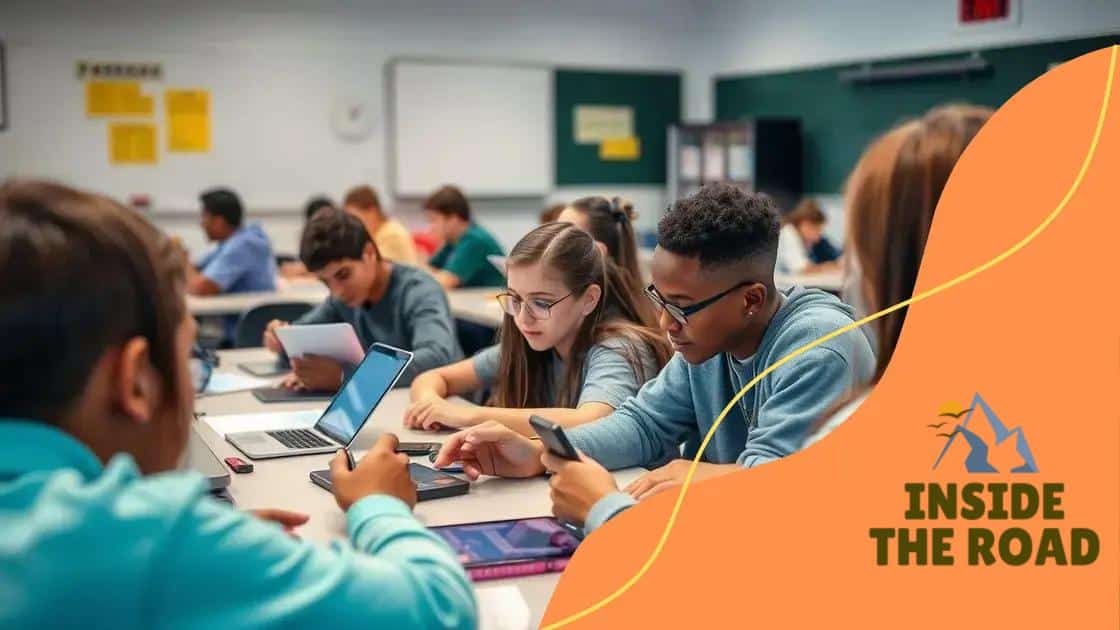How digital literacy programs are changing education systems

Digital literacy programs are transforming education by equipping students with essential technology skills, promoting critical thinking, and fostering responsible online behavior to prepare them for the demands of a digital world.
How digital literacy programs are changing education systems is a topic that resonates deeply as we navigate an increasingly digital world. Have you noticed how technology is reshaping classrooms? This article explores the significant impact of these programs on students and educators alike.
The importance of digital literacy in modern education
The importance of digital literacy in modern education cannot be overstated. As the world becomes increasingly digital, students must develop new skills that prepare them for a technology-driven future. Digital literacy encompasses more than just using computers; it involves critical thinking, creativity, and the ability to navigate online resources effectively.
Why Digital Literacy Matters
In today’s classroom, technology is a tool that enhances learning. Schools that prioritize digital literacy are equipping students with the skills they need to succeed. The benefits include better engagement, improved problem-solving skills, and the ability to find and evaluate information.
- Enhances learning and engagement in students.
- Prepares students for the workforce.
- Supports collaboration and communication skills.
Furthermore, digital literacy is crucial for fostering a sense of responsibility. As students learn to navigate the internet, they also gain insight into online safety and ethical behavior. This understanding helps them make informed decisions in their digital lives. With digital tools at their disposal, students can collaborate on projects effortlessly, fostering teamwork and innovation.
Building a Foundation for the Future
To adapt to a changing world, education systems must emphasize digital skills early on. Programs integrating technology allow students to practice using tools they will encounter in higher education and the workplace. This early exposure builds confidence and competence in their abilities.
As educators embrace digital learning, they also inspire students to be lifelong learners. The ability to adapt to new technologies will benefit students throughout their lives, as industries evolve and require new skill sets.
In summary, the integration of digital literacy in education isn’t just beneficial—it’s essential. By emphasizing these skills, schools prepare students for a successful and fulfilling future in a world where technology reigns.
Key components of effective digital literacy programs
Key components of effective digital literacy programs are essential for ensuring that students gain the skills they need for a digital world. These programs should be thoughtfully designed to provide a solid foundation in technology usage. Understanding these components helps educators create a more impactful curriculum.
Essential Skills
First and foremost, students must learn essential skills that encompass both technical and critical thinking abilities. These include the ability to use various digital tools, to search for information online, and to evaluate the reliability of sources. By emphasizing these skills, students become competent in navigating the vast amount of information available today.
- Basic computer skills and software knowledge.
- Research skills for finding quality information.
- Critical thinking to evaluate online content.
Another key component is fostering a sense of digital citizenship. Students should understand how to behave responsibly online. This includes knowing the importance of privacy, respecting intellectual property, and engaging respectfully in digital communications. Developing these awareness traits prepares students for safe and ethical online interactions.
Hands-On Experience
Effective digital literacy programs also incorporate hands-on learning experiences. Students benefit from practical applications of their skills, such as working on group projects, creating digital presentations, or engaging in coding activities. By working together, they not only enhance their technical abilities but also build teamwork and communication skills.
Furthermore, continuous assessment and feedback are vital for progress. Regularly evaluating students’ understanding helps educators adjust their teaching approaches. Providing constructive feedback encourages students to reflect on their learning and identify areas for improvement.
Incorporating up-to-date technology is also crucial. Digital literacy programs should integrate the latest tools and platforms that students may encounter in their future careers. This exposure helps ensure that students are ready to adapt to new technologies as they arise.
Challenges in implementing digital literacy initiatives

Challenges in implementing digital literacy initiatives are significant, and they can affect the overall success of these programs in schools. While the importance of digital literacy is clear, various obstacles can hinder effective implementation. Understanding these challenges is the first step toward overcoming them.
Access to Technology
One of the main challenges is ensuring that all students have access to the necessary technology. In many schools, especially those in low-income areas, there are insufficient devices for each student. This digital divide limits opportunities for learning and engagement. Access to reliable internet connectivity is also essential; without it, students cannot fully participate in digital learning activities.
- Lack of devices for every student.
- Unequal internet access in different regions.
- High costs associated with technology maintenance.
Another challenge lies in the training and support for educators. Teachers need professional development to effectively teach digital literacy. Many educators may feel unprepared to integrate technology into their lessons due to a lack of training or resources. This can lead to frustration and ineffective teaching practices.
Curriculum Integration
Integrating digital literacy into the existing curriculum can also be difficult. Many schools already have established programs that may not prioritize technology skills. As a result, educators might struggle to find time to teach these essential skills. Additionally, some educators may resist changing their teaching methods, which can impede progress.
Furthermore, resistance from parents or the community can pose a significant barrier. Some parents might not understand the value of digital literacy, leading to skepticism about its importance in the curriculum. Engaging parents and the community is crucial to garnering support for digital initiatives.
Finally, assessing student progress in digital literacy can prove challenging. Traditional assessment methods may not effectively measure a student’s digital skills. Schools need to develop reliable ways to evaluate students’ abilities and ensure continuous improvement in their digital literacy.
Success stories from schools adopting digital literacy
Success stories from schools adopting digital literacy initiatives showcase the transformative impact these programs can have on students and communities. Many schools have embraced digital literacy as a critical component of their curriculum, leading to remarkable improvements in student engagement and learning outcomes.
Improved Student Outcomes
One notable example is a school district in California that implemented a comprehensive digital literacy program across all grade levels. After just one year, the district reported a significant increase in students’ reading and math scores. By integrating technology into daily lessons, teachers were able to create interactive and personalized learning experiences that captivated students.
- Enhanced engagement through interactive learning.
- Higher academic performance across subjects.
- Boosted confidence in using technology.
Additionally, schools that have prioritized digital literacy often report improved critical thinking skills among students. A middle school in Texas integrated coding workshops into their curriculum, allowing students to dive into problem-solving and logic. This initiative not only taught essential tech skills but also encouraged creativity and collaboration. Students who participated in these workshops showcased their projects at a local tech fair, drawing attention and praise from the community.
Community Involvement and Support
Success in digital literacy initiatives often extends beyond the classroom. Schools in New York established partnerships with local businesses, providing students with internships and real-world experiences. These collaborations help students apply their digital skills in professional settings, further motivating them to excel academically.
Moreover, parent involvement plays a crucial role. Many schools host workshops to educate parents about the benefits of digital literacy. By engaging families, schools create a supportive environment where students feel encouraged to embrace technology. This cohesion between home and school fosters a culture of learning and exploration.
In conclusion, the success stories from schools adopting digital literacy highlight the potential for positive change. By focusing on technology skills, schools not only enhance academic outcomes but also prepare students for future careers in a rapidly evolving digital landscape.
Future trends in digital literacy and education
Future trends in digital literacy and education reveal exciting possibilities for students and educators alike. As technology continues to advance, digital literacy programs will evolve to meet the needs of modern learners. Understanding these trends can help schools prepare for a dynamic educational landscape.
Increased Integration of Artificial Intelligence
One significant trend is the growing integration of artificial intelligence (AI) in educational settings. Schools are beginning to utilize AI tools to personalize learning experiences for students. These tools can help identify individual strengths and weaknesses, allowing teachers to tailor lessons accordingly. For example, AI can recommend resources or exercises based on a student’s specific needs.
- Personalized educational pathways for each student.
- Real-time feedback on learning progress.
- Enhanced engagement through adaptive learning technologies.
This personalized approach not only improves learning outcomes but also keeps students motivated. Furthermore, as students interact with AI tools, they gain essential skills for the future job market, where AI will play a crucial role.
Emphasis on Coding and Computational Thinking
Another trend is the increased emphasis on coding and computational thinking in the curriculum. Schools are recognizing that coding is an essential skill for the 21st century. By introducing coding at an early age, students learn how to think critically and solve problems effectively. This foundational knowledge allows them to venture into various fields, including tech, engineering, and science.
Programs that focus on coding often include hands-on projects, which keep students engaged and excited. By building their own games or applications, students not only learn technical skills but also creativity and collaboration.
Focus on Digital Citizenship
As digital literacy evolves, there will be a stronger focus on digital citizenship education. Teaching students how to navigate the internet safely and responsibly is becoming increasingly important. Schools will prioritize lessons that cover online privacy, cyberbullying, and the ethical use of information.
Educators will also encourage students to become positive digital citizens. This includes promoting respectful communication and collaboration online. With a comprehensive approach to digital citizenship, students will be better prepared to face challenges in their online interactions.
In summary, as technology continues to shape the future of education, staying informed about these trends in digital literacy will be vital. By adapting to these new realities, schools can create more effective learning environments that prepare students for the complexities of the digital world.
FAQ – Digital Literacy Programs in Education
What are digital literacy programs?
Digital literacy programs teach students how to effectively use technology, navigate the internet, and develop essential skills for the digital age.
How do digital literacy programs benefit students?
These programs enhance critical thinking, improve academic performance, and prepare students for future careers in a technology-driven world.
What is digital citizenship?
Digital citizenship refers to the responsible and ethical use of technology and the internet, including issues like online safety and respectful communication.
Why is coding important in education?
Coding encourages problem-solving and creativity, and it helps students develop skills that are increasingly valuable in many fields.






